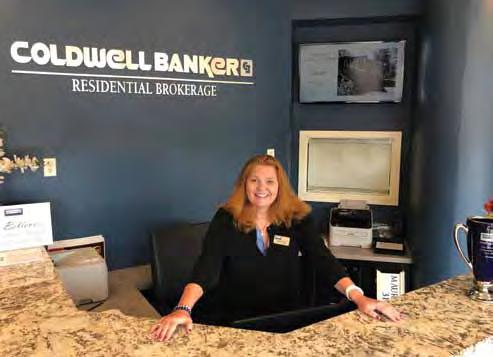
9 minute read
COPING DURING A PANDEMIC Stop the World I Want to Get Off
Stop the World, I Want to Get Off – Coping During a Pandemic
WRITTEN BY: ANNEMARIE SLIBY
Stop the World I Want to Get Off is a musical that debuted October 3, 1962 on Broadway. Although the musical’s storyline is much different, the title describes how people may feel about the year 2020—the year loved ones passed, businesses closed, and jobs were lost due to a world-wide pandemic that started just before 2020 began.
As the country went into lockdown in March, a virtual way of life was launched. While essential businesses remained open and thrived, others closed, with some trying to survive virtually. Working from home was the norm and offices soon became a staple in every home. Online platforms such as WebEx, Zoom, and Google became household names-utilizing it for teaching, business meetings, friendly chats, physical fitness, or even virtual happy hours.
The town prepared for a medical emergency weeks before the lockdown. Committees were put in place to prepare the school district, business community, and general population.
SCHOOL DISTRICT
Dr. Vince Scarpetti (Superintendent of Schools), Dr. Amir Mohammad (the town’s Director of Health), and various committees began planning for alternate learning should a lockdown happen.
Scarpetti says, “We were focused on being proactive, but it was still shocking---school is in session, and suddenly, we get the call we are closing. Because of our preparedness, we were able to provide assignments the week after shut-down.” Virtual learning was initiated via Google Classroom (where teachers would post assignments) and Google Meeting (where teachers and staff attended meetings). This type of learning continued until summer break began.
REOPENING PLAN
The planning continued all summer for the school district’s reopening in the fall. Scarpetti says, “The health and safety of the students and staff were at the forefront of our thinking and planning.” Dr. Mohammad made himself available for multiple meetings a week. The reopening committee, parent feedback, and collaboration of key stakeholders were also critical in the reopening plan.
A variety of educational models were proposed. Dr. Scarpetti says, “What we learned from being shut down last spring became a driving force for what we are doing now and what we will do if we move to full remote learning.” We continued to focus on technology, instruction, ventilation, cleanliness of buildings and the social, emotional and well-being of our staff and students.
Dr. Scarpetti emphasizes the importance of creating multiple streams of communication and systems to mitigate the chance of exposure to COVID-19. Systems include communication via central office emails, board meetings, weekly school eblasts, website postings and open dialogue with those who contact district personnel. Mitigation systems include social distancing, mask wearing, regular hand washing, improved ventilation systems, heightened cleaning routines and cohorting. A child’s cohort consists of the students in his or her homeroom class and allows members to quarantine, as needed, rather than having to close an entire school or district.
School districts across the state are currently operating in a variety of learning models including full inperson, hybrid, and remote. Orange Public Schools have implemented a full in-person learning model, with few parents choosing remote
The banner that sits on the fence outside of the Orange Fairgrounds donated and produced by Sign-A-Rama at the beginning of the pandemic.

Photo: Paula Severino
learning. At press time, the district was at 8.9% full in-person learning. Dr. Scarpetti says, “We are prepared to ramp up or down, depending on the number of COVID-19 cases and the guidance of our Health Director.”
THE TOWN’S RESPONSE
The Orange Emergency Management Advisory Council (EMAC) coordinates the town planning and response to major emergencies under the direction of the office of the First Selectman, through our Local Emergency Operations Plan. This plan is developed, updated, and expanded on an ongoing basis in cooperation with all town departments who have a role in times of emergency. Ongoing monthly meetings of the standing EMAC serve as the primary mechanism.
Prior to lockdown, when it became apparent a pandemic was rapidly impacting our nation and our community, Emergency Management began to implement the town’s emergency response. Tino Russo, Deputy Director of Emergency Management, organized a dedicated COVID-19 committee, established under the EMAC. Members consist of Dr. Amir Mohammad, Brian Slugoski (the town’s Sanitarian), Chief Robert Gagne (police), Chief Vaughn Dumas (fire), as well as other department officials. This committee, still in place, is responsible for monitoring the overall situational awareness, sharing and clarifying safety guidelines to our general population and business community, and initiating the town’s coordinated response through all phases of the pandemic. The First Selectman communicates with the committee constantly regarding the town’s status.
Russo says, “Managing the critical need for PPE was a significant challenge. Flows from multiple sources including state government, health districts, business associations, and others were in critically short supply.” Through the COVID-19 subcommittee, the town’s aggregate supply was distributed. This included outreach to our businesses, medical facilities, faith community and others to provide basic Personal Protective Equipment (PPE) to assist these segments of our community beginning to reopen in a safe, compliant manner. The committee will continue until the pandemic progresses to conclusion.
HEALTH DEPARTMENT
Aside from EMAC COVID-19 committee meetings, Brian Slugoski and Dr. Mohammad are in constant communication with each other, speaking up to six times a day. Under the direction of Dr. Mohammad, Slugoski is focused on case management interviews, contact tracing, and following up with COVID positive patients.
Dr. Mohammad explains there is a delay in the state’s database reporting system by a day or two and this will delay the health department’s contact tracing. Therefore, it is important the public contact the health department when a positive test is received. Mohammad says, “Please call us or send an email as soon as possible so we can start contact tracing earlier. If someone was exposed in a large gathering or is a teacher, the risk is higher, and we need to start tracing to prevent the spread.”
Slugoski also performs spot checks on businesses and responds to complaints from the public. Slugoski says, “When I get complaints about businesses, I try to educate the business community on various ways to comply with COVID guidelines. I want the business population to know they can reach out to us with any questions they may have—we are always willing to help.”
Dr. Mohammad recommends the business community stagger their workforce so if an employee is COVID-19 positive, only half the staff would have been exposed; therefore avoiding a complete shut down for 14 days due to a full-staff quarantine.
THE BUSINESS COMMUNITY
Essential businesses remained open during lockdown and some did better than others. Even though the hotel industry was deemed essential and remained open, the Courtyard Marriott had a difficult time, whereas Homewood Suites by Hilton did very well.
“It all has to do with how the brand is positioned in the market,” says Lauren Kocivar, General Manager at Courtyard by Marriott at 136 Marsh Hill Road. “The Courtyard offers a guestroom and caters to business clientele, whereas the Homewood Suites is an extended-stay property. People were looking for a place to live.”
Kocivar explained when businesses closed at the start of the lockdown, business travel stopped, and people began working from home. “The new work-from-home way of life greatly affected the Courtyard brand all around,” says Kocivar.
Because the rooms at the Homewood Suites by Hilton are equipped with full kitchens, it was desirable for families needing alternate dwellings for quarantine purposes, or professionals in the medical field working in the area, as well as those families whose
homes were damaged from storms during the summer. Having an indoor pool and fitness center was also attractive to clients.
“I focused on keeping our amenities going to attract clients and worked with the town’s sanitarian, Brian Slugoski to understand and comply with safety guidelines,” says Tom Falco, General Manager of Homewood Suites by Hilton at 99 Marsh Hill Road. “It was important the fitness center, pool and our hot breakfast service remained open, and I wanted to do what was possible to keep that going.” Falco also reduced the occupancy in rooms from six (normal maximum capacity) to two clients per room, keeping everyone safe. Because of this, Falco says, “Clients were booking two rooms at a time.”
To keep an eye on cost, while experiencing a loss, the Marriott shut down utilities on half their building, while booking rooms in the other half. When leisure travel was allowed, they opened the full building and were busy. Local families were booking rooms for staycations, utilizing the outdoor pool. Kocivar says, “We opened the pool in June and used a reservation system to keep everyone at a safe distance. Reservations were made at the front desk for one-hour time slots.”
They also gained clients attending weddings and sporting events in the area. Currently, reservations are down now that the summer is over and Kocivar says, “Business travel is only at 10 percent of what we usually do at this time.”
COMMUNITY SUPPORT
The community made it a point to support local restaurants to keep them going. While indoor dining was closed, restaurant owners relied on takeout and delivery. Redi Kostandini, owner of Andini’s says, “When takeout was the only option in the beginning, our regular customers came out to support us and kept us busy.” Kostandini explains when liquor was allowed with takeout orders, customers would buy bottles of wine with their dinner, and recalls one customer buying a case with his order--the customer saying ‘We want you here, we want you to make it.’ In addition, his regulars purchased gift cards for future dining or takeout.
Businesses in the area also gave the popular restaurant support. Jim Watson, president of Watson’s Food Company, located at 50 Prindle Hill Road, purchased food weekly for his entire staff for over a month. Kostandini says, “Support from the community was incredible and I am so thankful.”
VIRTUAL FITNESS
The fitness industry had to be creative to keep their client base. In order not to lose their members, fitness centers held virtual classes and training via online platforms. Shirley Chock, owner of Aiping Tai Chi Center at 518 Boston Post Road offered free live streaming classes via twitch.tv for their members and held classes outside at Eisenhower Park as well.
Since Phase Three of the state’s reopening plan, Shock says, “We
Photo: Paula Severino

Colonial Properties showing support to first responders with a sign located at the corner of Old Tavern and Racebrook Road.
began teaching classes inside the school in October one day per week and it went very well.” On November 1st, the Center increased to two days a week and is operating at 40 percent capacity, which is 4 classes per week, with 8 members per class, and everyone must wear a mask.
LOOKING FORWARD TO A NEW YEAR
Healthy or unhealthy, COVID-19 has affected us all. We want things to return to normal soon, that 2020 can be put behind us, and this can be a distant memory. As we move into 2021, let us remember what is important and have faith that we can, as a community, continue to get through this pandemic together.
READ THIS ISSUE AND PAST ISSUES AT: OrangeLife.net
When visiting any of the businesses that have advertised or that are featured, please let them know you saw their ad or article in OrangeLife. Thank you to First Selectman, James Zeoli; Orange Economic Development Commission; and Orange Economic Development Corporation board members; as well as our advertisers for your support.












